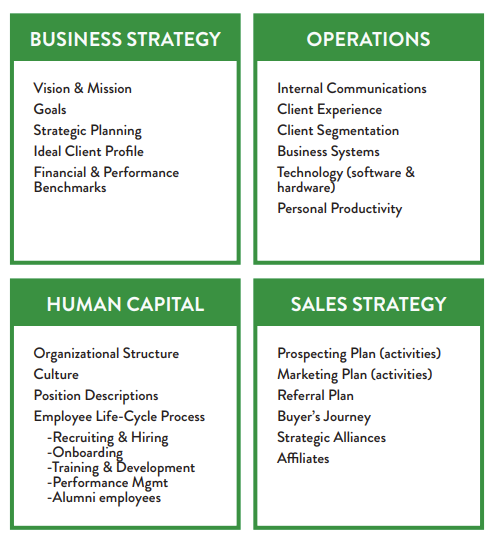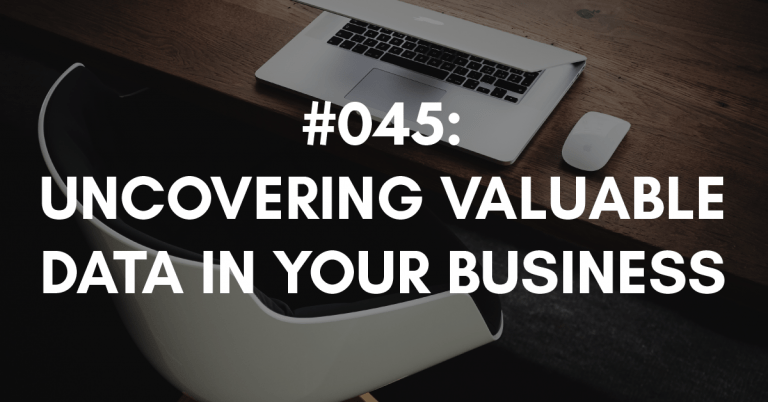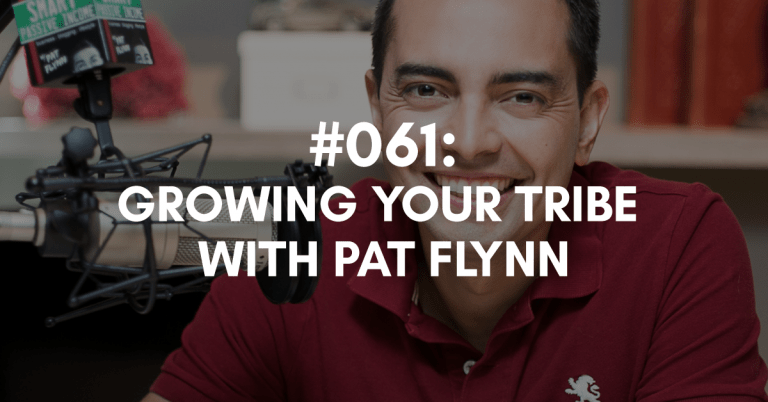Ep #197: 4 Quads of Business
Do you ever feel like there are parts of your business that are going amazingly well? Things are happening in a way that feels good—in fact, it makes your heart sing. On the other hand, there are some things in your business that you know could use a little more time and attention. Well, you’re not alone. We’re all like that. However, there is a strategy that I use to help me figure out the gaps for improvement, and in this episode, I am going to teach it to you.
Way back when I was a productivity and business coach, I helped business owners look at their business using my 4 Quad Method. I am going to walk you through this method right now and share where I would categorize myself in each of the 4 quads.
The 4 Quad Business Model

Share your thoughts on this episode or ask any questions you have in our Referrals Without Asking Facebook group!
Looking for Referral & Client Experience Resources:
Take the Referral Ninja Quiz to test your skills and abilities at generating referrals. (FREE)
Buy my book – Generating Business Referrals Without Asking – and learn how to generate referrals through my 5 steps. (LESS THAN $16)
Consider joining Building a Referable Business™ – a unique way to learn all of my referral strategies and tactics with ongoing weekly access to me to answer your questions and help hold you accountable! Email me for more details.
Coming Up:
Next episode is #198 where we will be starting a two-part series on types of business owners.
Download The Full Episode Transcript
Read the Transcript Below:
Stacey Brown Randall: Do you sometimes feel like there are parts of your business that are going amazingly well? There are just those things that are moving and grooving in a way that makes you feel good, makes your heart sing? But there are also areas of your business that just need some more time and attention. Well, you’re not alone. We are all like that. But there is a strategy that I use to help me figure out the gaps for improvement. And I want to teach it to you.
You are not just another hustling salesperson. You are the expert, the
resource, the valuable partner for your clients, and how you grow your
business should reflect how your clients see you.
Welcome to the Roadmap to Grow Your Business podcast. We generate
referrals without asking, build positive client experiences, and help
you take control of your business.
Here’s your charmingly sarcastic host, Stacey Brown Randall.
Stacey Brown Randall: Hey, there. And welcome to episode a 197 of The Roadmap to Grow Your Business Podcast. I’m your host, Stacey Brown Randall. Okay. Real quick, before we dive in to this episode, I want to do two things. One, can we just take a minute and just think about what it means to hit 197 episodes? Knowing that I’m coming up on episode 200 pretty soon, it’s just the reminder to me that I have done something consistently for 197 weeks. Years, my friends. Years. Every single Tuesday, a new episode drops, and I hope you’re enjoying them.
And if you are enjoying them, I would really love a rating and written review on your favorite podcast listening app. That would mean the world to me. And you may actually be ahead for some of the stuff you’d want to do when we get to episode 200. But 197 episodes, 197 weeks of commitment. I’m actually pretty proud of myself. I’m not sure how many things I’ve committed to like that on an ongoing basis for that long. Maybe taking my vitamins.
Okay. Anyways, let’s move on. Let’s do a quick client shoutout. So I want to give a shoutout to a real estate agent named Tara. So fun working with her. She came to me because she actually has a really strong referral based real estate business. She does get a number of referrals every year. And obviously it helps that she’s been a real estate agent for more than just a couple of years. She’s been a real estate agent for a while. But she wanted to up her game because she wanted to make sure that she had a plan and a consistent strategy to follow, to be able to generate referrals, almost in the little things. Like the nuanced ways.
So that was the first thing. But the second thing, which actually ended up being more pressing, was that one of her best referral sources was moving, was leaving the state. And would not be in the community to be able to send people to her, to be able to refer people to her. And she wanted to close the gap. So whereas we wanted to increase the number of referrals received, we really wanted to start out in our first year by closing the gap of what she was going to lose by that one referral source moving out of state and no longer referring her.
And whereas yes, it was looking for new referral sources, it was also being able to receive more referrals from those that were already referring her, her existing referral sources, and looking at that strategy to really close the gap. And I am so proud to say that she received, in one full year, her first year following the plan, 25 referrals. And those 25 referrals, of the ones that she closed was worth $292,000 in revenue. That’s almost $300,000 from her referrals.
I tell this story about Tara, because I think a lot of people, we’re naturally impressed when someone’s like, hey, I’m getting 20 referrals a year. And then I worked with Stacey and now I’m getting 50 or 60. Or someone who goes from, hey, I got three or four referrals a year, now I’m getting 20 a year. We look for the big jumps in numbers, but sometimes it’s not about the big jumps in numbers. That is why you need to have a referral strategy in place, or a few referral strategies in place. Sometimes what you’re looking for is the consistency and the ability to have referral sources give you more, because you’re looking for a different type of strategy. Which is the right kinds, the best quality referrals so you’ll have a higher closing ratio.
And in addition to that, being able to know that you have a strategy in place that can close the gap when you lose one of your better referral sources. There’s lots of different reasons why a business would decide, I’ve got to get serious about my referrals. And Tara’s example is a perfect one that says, hey, I’m good with the referrals. I do really good work and take really good care of my clients and have this ability in my business where I’m already generating referrals. But I want to make it better, specifically for a few reasons. And then that’s why she dove in to making referrals happen.
So, really proud of her, really proud of the success that she had, and really, really proud that she had almost $300,000 in revenue from those referrals. So sometimes it’s just increasing a closing ratio or getting better quality referrals. Or just knowing you have a strategy in place so that you are taking the best care possible of your referral sources. And in some cases, that’s just to maintain what you’ve always received. Not because you’re necessarily trying to double, triple, or quadruple the number of referrals received.
So think about that from your perspective. It doesn’t have to be this massive referral explosion you’re going after. It could just be an improvement in your processes and your systems, or taking better care of your referral sources. Or knowing that you can close the gap if you were to lose a referral source. Or better quality or increasing your closing ratio, there are so many. We call all those things our situational referable strategies, which of course we teach in Building a Referral Business. But remember, where you are right now, will decide what you need from a really good referral strategy. You just got to take the time to figure it out, like Tara did.
Okay. Let’s dive into today’s episode. Way back in the day, when I was just a little girl … I’m totally kidding. Way back in the day though, when I was, well, younger, I was a productivity and business coach. And most of you probably know that because it’s in my bio. We talk about it in my book. And of course, I’ve talked to about it on this podcast before. Actually, in the last episode, when we talked about the speed of starting small. And the episode before that, when we talked about putting your busyness in perspective.
But way back in the day when I was a productivity and business coach, I helped business owners look at their business through what I called my four quad method. It was the four quads of how we look at how our business is performing. So if you are not driving right now, or running, or doing whatever you do while you listen to podcasts, and if you happen to be sitting at your desk and you pulled out a piece of paper, I would tell you to draw four quads. Four boxes, right? So put a T in the middle and then connect the dots around the outside and you’re going to create your four quads.
So imagine it is basically four squares. What I’m going to do is I’m going to walk you through what fits in each of those squares. And we’re going to put the exact image or the visual, on the show notes page. So there’s nothing to download. You just need to go to the show notes for this episode. The show notes page for this episode is staceybrownrandall.com/ 197. That’s for episode 197. And Stacey, of course, has an E. So if you go to the show notes page, you’re actually just going to see the image. Pull up your phone, screenshot it, take a picture of it, whatever you’re going to do so that you can actually see what fits in these four boxes. I’m going to walk you through those four boxes right now. And then the strategy that I use to figure out how I would rate myself in each of them.
But if you were just doing this right now and you didn’t have the show notes in front of you and you pulled out a piece of paper, you’d basically just create four quads, right? Just draw your four squares, your four boxes. And this is how you would label them. In the upper left, you would label it, Business Strategy. To the right of that, so in the upper right, you would write, Operations. In the bottom left, you would title that box, Human Capital. And in the bottom right box, you would label that One Sales Strategy. Okay.
So we’ve got business strategy, operations, human capital, and sales strategy. So when you think about right, what this four quad business model looks like, there are things within each of those four boxes that are the things you want working well in your business. These are the things that you want of the things that you need, right? When we get to the human capital box, if you are a business owner of one, if you’re a solopreneur, it’s just me, myself and I, there are some things I’m going to talk about that you don’t need, but you may need in the future. So some things aren’t necessarily applicable to every business, in every way. You’re going to have to pick and choose what actually fits for you in that perspective.
But when we look at these four quads and we can hone in on how we’re doing in each of these boxes, by the things that make up each of these boxes, it gives us a really good 30,000 foot view snapshot of what’s working and what needs improvement. And ultimately, we don’t set out to improve all the things at one time that need improvement. That would be crazy. But it does allow us to understand the things that we want to fix in our business. And then we decide, great. Now what’s the priority? And then in what order will we go? Because again, unless you have a large team, you’re not solving all of these issues at one time.
But I recommend to you whether you are a solopreneur and it is just the me, myself, and I show with some maybe contractors or virtual assistants helping you out. Or you have a team, whether that’s a small, but mighty team of two, three, four, five people or a larger team, where maybe you have 10, 15, 20 folks either way this four quad method will work for you. Because when you think about exactly what that means, it just means as you apply each piece within these four quads, you’re just applying it to the version of your business is today. So regardless of your size, no matter how small, no matter how big, this fits.
Now, the larger your business gets, there’s probably more things that need to be included. But in the interest of, well, let’s be honest, not overwhelming you and keeping it to what’s really important, it’s not like there’s 50 things in each box. Each box has somewhere between five and seven things in each box. So let me break those down for you. And then after I break them down for you, I’m going to teach you how to go through and figure out what’s working and what’s not.
Okay. Let’s talk about business strategy first. And we’ll just go in the order in which I first labeled them. So we’re going to start with business strategy. So the first thing in business strategy is the vision in mission. Now there is lots of debate about what’s the difference between a vision and a mission, and you can look them up on Google and lots of great articles can explain that to you. You just need to decide, do you have a vision, and do you have a mission? Or do you have a vision that is a mission. I mean, I can hear a lot of business consultants out there saying, your vision cannot be your mission. But regardless, you need to know where you’re going. You need to know where you’re going and why you’re doing it. And you need to know what you ultimately are hoping to achieve. And that’s your vision and your mission.
Then the second thing in our business strategy box are your goals. And if you do the reverse goal setting process that I do at the end of every December with you guys on this podcast, or whether you went through a workshop or you actually just have the replay of that workshop, or you just listen to the episodes in the podcast, your goals do start with the end in mind, right? We do look five years out and then reverse into the actual goals for this year. In this box for the business strategy, it would be really all of that. It would be your goals for five years out, your three year milestones, and your one year plan, which is effectively your one year goals. But it’s the things you’re trying to accomplish.
Also in the business strategy box would be strategic planning. Any short term or long term planning that you are doing. Sometimes you have a goal of what you want your business to accomplish, but it takes some strategic planning and really mapping that out to figure out how you’re going to get there. I didn’t wake up one day in my business and just decide, hey, I need to do Building a Referable Business. That’s just the next offering that I need to offer to people to be able to work with me and learn my strategies, but also have access to me. I actually paid attention to the things that I thought were working really well in my business, from the perspective of helping my clients, and the things that I thought could just use improvement.
And from there, and conversations … not only in my own head, but with other people that I trust. My business buddies that I go to when I have questions and that I want to talk things through. When I started paying attention to what my clients needed and what I was ultimately after as a business owner of how I want to serve my clients and how I want to run my business, I realized that some of the things that I had said as a goal were going to need some strategic planning to actually get me there. And then over to time, that is what evolved for me into solving one of my issues in my business, was Building a Referable Business. And now that we’re four months in, I can say. Best decision ever. I am loving it. And so are my clients that are in BRB.
But so vision and mission, goals, strategic planning. The next is your ideal client profile. You do need to know who is your ideal client. Now, whether you do this from a persona, or you do this from an avatar, I don’t really care. It doesn’t really matter to me. I just think it’s important that you understand who is your ideal client, because it informs so much about how your business operates. From its internal and external communication, its messaging, its sales strategy, its process, the things you use to actually bring in prospects into your pipeline. Everything is informed with who is your ideal client profile. And that’s not to say you won’t have multiple ideal client profiles, but maybe you don’t. Maybe you have one. Again, you just need to know who you best serve. And that’s part of your business strategy box or quad.
And then the final thing is your financial and your performance benchmarking. How are you tracking how you’re doing and benchmarking yourself against where you’ve been and where you want to go, in addition to where you are right now? So it’s that financial and performance benchmarking. So those are the things that make up the business strategy box. Again, they’re vision and mission, goals, strategic planning, ideal client profile, financial and performance benchmarking.
Now let’s move to the next box, which is our operations box. And this is the box in the upper right. So your operations box includes things like internal communication. So if you’re a business of one, your internal communication and are still the things in the processes of how you communicate. It could be with a virtual assistant or with people that you hire, right? Vendors that you hire to help you, whether those are contractors or companies. There is still a level of internal communications, even if you are a business of one. It’s not just all the communication you have with yourself, it’s also the communication you have with the people who help you run your business, even if they’re not an employee. But of course, if you have employees, then internal communications is a big one.
Of course, also in the operations box is the client experience process. I’m a big believer in you having a referable client experience. And how you deliver that for your clients is super important. Also in the operations box is your client segmentation. How do you segment out your clients either by offerings or what you do for them? So it’s really important that you think about the clients that you have, and then how you provide the service or product that you provide to them.
Your systems are also in the operations box. All your business systems, whether that is, in some cases, how the business runs. The system of how we bring a client in and what that system piece looks like, all the way down to your telephone system, if you have that. So that’s important for you to think about from the perspective of your business systems. And also in the operations box, it wouldn’t be the operations box without technology. Let’s be honest. Whether that’s software that you use to run your business or the hardware that you use to run your business. And that you provide to employees, if you have employees as well.
And then I also … and I think people can make the argument here that this doesn’t fit in the operations box. But I personally believe that your personal productivity fits in the operations box as well. How you stay productive in getting the parts of work that your responsible for done, and holding other people accountable, as well as the owner of the business. Your personal productivity fits in your operations box as well. So operations, again, is internal communication, client experience process … really should be referable. Client segmentation, business systems, technology, the software and the hardware. And of course, your personal productivity.
Okay. Let’s drop down into the bottom left, the human capital. The people part of business. Now again, if you don’t have any employees, some of this won’t fit for you right now. But if you have intentions to grow and bring on employees, even if it’s just one or two people in the future, this is something to pay attention to. And if you have a team of three, five, 10 people than obviously … or more, of course. Than obviously this box very much matters.
So human capital. Number one, it’s your organizational structure. And I like to look at the organizational structure in two ways. One, it’s the, what it looks like today, and who’s responsible for what. But then two, what it looks like in the future. So if you do have plans to grow, and grow your team specifically, what does that look like? Where are you headed? I think knowing what your future org chart would look like, even if it feels like a pipe dream right now to map it out, it’s just a really important exercise to go through of, okay, when I add people, where would I add people? It also helps you understand the very first hire you may make is an assistant, or even if it’s a virtual assistant, what the heck would you give this virtual assistant? And so mapping out your future org chart, I think sometimes help you clarify in your mind, the things that you don’t necessarily have to be doing in the future.
Another piece of your human capital, in addition to organizational structure, present and future, is also your culture. Now, if it’s just you running the business, your culture is your culture. But if you have people, that is something you need to be intentional about, because your business will have a culture, whether you’re intentional or not. Next in the human capital box is your position descriptions. It’s the, who does what, and mapping out the duties of each position that you have.
And of course, in the human capital box is the employee lifecycle process. So if you have employees, it is part of that lifecycle process. It’s the recruiting and the hiring. It’s the onboarding, the training and development, the performance management, right? And then, of course, employees don’t stay forever. So if they do eventually leave or you have to exit them out, it’s knowing that they are eventually no longer employees or alumni type employees of your business as well. But that is the employee life cycle and how you have processes and procedures and manage the pieces of that employee life cycle for those five things. So again, in the human capital box, it’s your organizational structure, present and future. Your culture, your position descriptions. And the employee lifecycle process, which includes recruiting and hiring, onboarding, training and development, performance management, and when a client becomes an alumni client.
Okay, now let’s move into the final box. It’s sometimes the box that people want to avoid, because it’s the sales box, it’s the sales strategy box. Which everything, every quad matters. That’s why these are connected as four quads, right? It’s not like you can just ignore one and everything will be fine. You can ignore one, but everything will not be fine for long. But this box is the box that people are like, oh, come on. I decided to start my own law firm because I’m an amazing attorney, right? Not necessarily, because I want to be amazing at being a business owner and being in sales.
I totally get it. But the truth is, this box is super important. Your sales box. So this includes the activities that make up your sales strategy. And if you’ve ever heard me teach this, you know I teach that you’ve got a prospecting piece to your sales strategy. You have a marketing piece to your sales strategy. And you have a referral piece to your sales strategy. And all three of those make up the sales strategy box. So again, it’s the prospecting things that you do. It’s the things that you do that are more short term in nature to try to find clients. Whether that’s cold calling … oh, I pray you don’t do that. Or you don’t have to do that. But it could be the cold calling. It could be the buying of leads. It could be all the networking that you do day in and day out. All the things that you do. Maybe it’s cold emailing that you do. Those are your prospecting activities.
Then we have our marketing activities. Website … please have a website. But that’s the website. Maybe that is also earned PR you go after or social media that you do or advertising that you do, any branding that you do. So that falls under your marketing. And I’m not giving you everything. I’m just giving you the pieces that fall under each of these. So if you’re like, wait, she forgot to add in X, Y, Z to marketing. I’m not ignoring it. I’m just not telling you everything because there’re a lot. And then, of course, there’s the referral piece. And this is what we talk about 80 something percent of the time on this podcast, so I’m not going to dive deep into that.
But those are the three plans that make up, or the three strategies that make up your overall sales strategy box, or quad. Prospecting, marketing, and of course referrals. So, that’s the four quads. All right. So now you understand what’s in the four quads again, go to the show notes page for this episode, if you need to, if you want to screenshot or take a picture. And save this four quads with all of that in there. The show notes page for this episode is staceybrownrandall.com/197.
Now here’s a super simple way that I go through and figure out, how am I doing. I first go through and I just decide, do I have this? Let’s just use business strategy for an example. Do I have a vision and mission for my company? Yes. Check. Do I have goals? Yes. Check. Do I have strategic planning? Do I have an ideal client profile? Do I have financial and performance benchmarking? And so I’ll check the things I have, and I’ll put an X by the things I don’t have. Then I’ll go back and I’ll decide even the things that have a check by them, are they where they need to be? And if they’re not where they need to be, I just make a little note of it.
Because anything that gets an X first, and I know I need to have it, that’s going to be at the top of the priority list. But anything that has a check, which means I have it, it’s just not exactly where I need it to be, it’s going to go next on the priority list. So again, you just go through and you’re like, vision and mission. Do I have them? And I don’t mean, do you have them in your head? I mean, could you send them to me as an email attachment? That tells me that you have them, right? That’s the check mark. If you don’t have them in writing where you can send it to me or send it … well, not to me. But to somebody, then it’s not a check. It’s more of an X.
So you go through and you just check the things that you have and you put Xs by the things that you don’t. Then you go back through and you look at the check marks and you just say, does anything need improvement? And if it doesn’t, it’s great. And if it does need some improvement, then you make a note that it needs improvement. And then you can create your list of priorities. You can look at, do I want to … usually people start with the things that are Xs. But maybe for you, it’s a matter of, actually, I need to improve this piece before I focus on the things that I don’t have. Great.
If you gave yourself a check mark by your referral strategy within the sales strategy quad, if you gave yourself a check mark because you are getting some referrals, but at the end of the day, you don’t really have a strategy or a process, or it’s not working the way you want, you make go back and denote that as needs room for improvement. And you may decide that is actually more important, to get your referrals piece going, before you decide to improve, let’s just say, your organizational structure and creating your future org chart, right?
So it is a matter of you deciding then in what order they go. But by having the checks and the Xs, and then the checks that need improvement denoted that they need improvement … maybe you circle them or put an I by those checks. That helps you figure out, okay, these are all the things I want to fix. Now, in what order do I want to go? Sometimes people start with the Xs, sometimes people start with the checks that need improvement, and you’re not doing everything at once. It’s like, give and take, right? Hey, I’m going to start with putting my referral strategy in place.
So back in episode 194, you guys heard from Joey. And Joey’s an attorney who went through the program, and they decided they wanted a referral strategy in place and they made it one of their quarterly rocks. It was one of their goals for the quarter to go through my program and implement a referral strategy that would be sustaining. They didn’t just deploy the strategy in that quarter. They took that quarter to learn it, implement it, and then they executed on it. And they continue to execute on it and that’s why they continue to get results.
So sometimes it’s looking at, what do I need to do first, and then second, and then third, and then revisiting the list once you’ve actually done those. I don’t know what is with me lately and having my ringer on every time I’m recording these episodes. So if you heard the phone ring, my apologies. Once again, amateur hour. My bad. Okay. So when you’re thinking through what you have, checks and Xs, and then what the check marks that need improvement, you’re going to create a list. And that list will go in whatever priority or order you put it in and then you’ll start solving it. And then you have to figure out how you want to solve it. But this is what being a business owner is all about.
Now, if you’ve got questions about how to solve any of the things in the four quads, I am happy to give you my two cents. You just got to jump into our Referrals Without Asking Facebook group, and either look for the post for episode 197, or start your own post and ask your question. Like, hey Stacy, listening to episode 197. I got a question about this ideal client profile in the business strategy box. Or I got a question about the client experience process in the operations box, whatever it is, ask your question.
Let’s be honest. If you’ve listened to this podcast for any length of time, you know I’ve got opinions on it. But I also may say, hey, that’s actually out of my realm of expertise, but I do have some resources I can direct you to. Or I’ll just help you frame up maybe what’s most important based on where your business is. But you got to get into the Facebook group, the Referrals Without Asking Facebook group. And you got to ask your questions or share your thoughts and feedback so we, of course, can have a dialogue. And again, if you’re not in the Referrals Without Asking Facebook group, just go to staceybrownrandall.com/community. And that’ll redirect you right into the Facebook group. You do have to answer three questions, and you have to accept that you will follow the group rules before we will let you in. So definitely take time to do that.
Okay, there you have it. That is episode 197, where we talked about the four quad method. I can’t wait to hear how you guys think and what you think and what you come up with, with your four quads, as you go through this exercise. All right, coming up next week is episode 198, and we are doing a two part series on the types of business owners. That is really cool. You’re going to love it. Don’t miss episode 198. And then of course the second one in the series, episode 199. But until then my friends, take control and grow your business. Bye for now.
Thanks for listening to the Roadmap to Grow Your Business podcast. To
access all resources and links mentioned in today’s show, and to
connect with Stacey, head over to www.staceybrownrandall.com.







